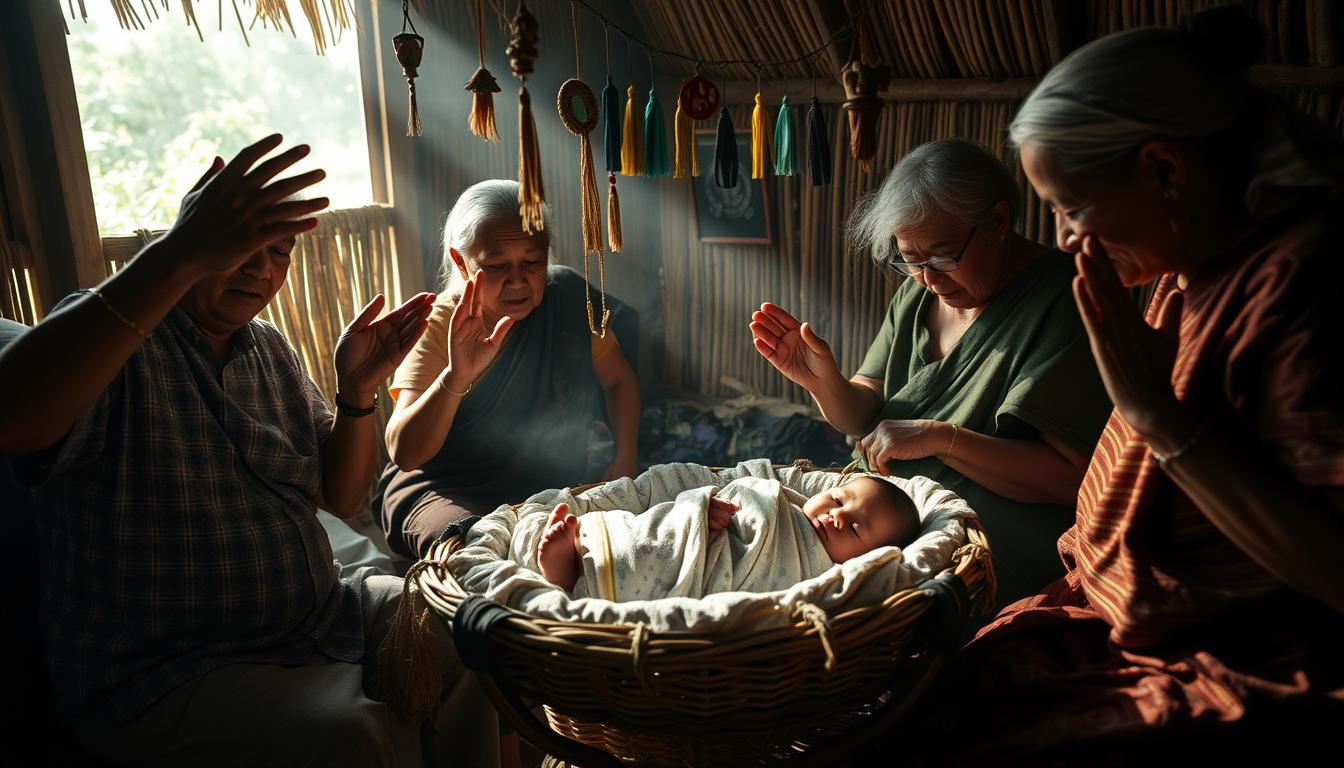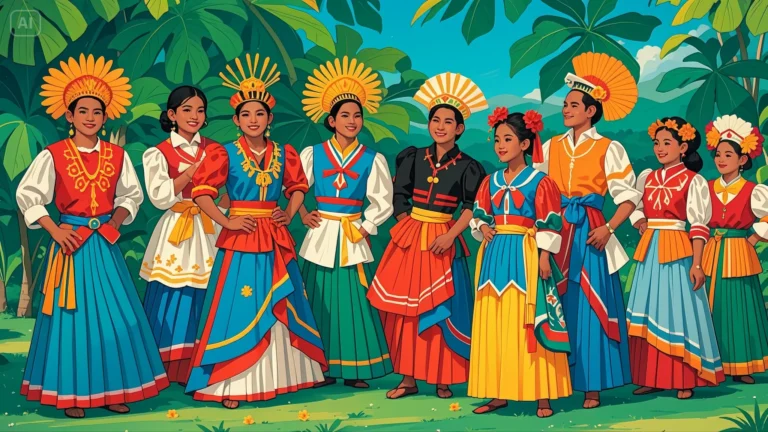Puera Usog: Filipino Infant Protection Traditions

In the Philippines, families have long relied on rituals to shield newborns from unseen dangers. One tradition involves visitors gently applying saliva to a baby’s forehead while whispering protective phrases like “pwera usog”. This practice aims to block harmful energies believed to cause fussiness or illness in infants.
Rooted in folklore, these customs reflect a blend of spirituality and community care. Strangers or guests might perform the ritual to neutralize the “evil eye”—a superstition where admiration or envy could unintentionally harm a child. Some families also mark babies with lipstick dots as an added safeguard.
The film “Pwera Usog” explores how modern Filipinos view these age-old practices. While urban lifestyles evolve, many still honor traditions that emphasize collective responsibility for a child’s well-being. From whispered blessings to symbolic gestures, these acts reveal a cultural bridge between history and contemporary life.
Key Takeaways
- Filipino traditions like saliva rituals aim to protect infants from negative energies.
- The phrase “pwera usog” is used to ward off superstitions affecting a child’s health.
- Lipstick marks or gentle touches are common symbolic safeguards.
- Communal participation reinforces cultural values around infant care.
- Modern media, including films, examines how these customs adapt over time.
Exploring Filipino Traditions and Historical Roots
Centuries-old Filipino traditions reveal a unique blend of indigenous spirituality and colonial influences. Protective rituals like countering usog—the belief that a stranger’s greeting could harm a child—reflect this cultural fusion. These practices show how communities historically interpreted health through spiritual lenses.

Historical Background of Usog Beliefs
Scholars trace usog to pre-colonial animist beliefs, later shaped by Hispanic folk traditions. Early accounts describe infants developing unexplained fevers after encounters with unfamiliar visitors. Families believed the “balis”—a person’s intense gaze or compliment—could disrupt a child’s delicate energy.
To neutralize this, communities developed saliva rituals. A stranger would moisten their thumb, touch the baby’s forehead, and whisper “pwera usog”. This act symbolized transferring protective energy while breaking any harmful spiritual connections.
Cultural Impact on Community Practices
These traditions reinforced collective responsibility for children’s well-being. Villages viewed infant care as a shared duty, not just a family matter. Historical records show neighbors often performed rituals if parents couldn’t find the original visitor.
Over time, the practice became woven into social interactions. Guests might greet newborns with gentle touches to preemptively counter usog. Today, urban families sometimes adapt these customs, blending them with modern healthcare while honoring ancestral wisdom.
Understanding Puera Usog and Its Protective Rituals
Filipino culture intertwines ancient beliefs with practical care for newborns. Rituals to counter harmful influences blend symbolic gestures with communal participation, creating layers of defense for vulnerable children.
Ritual Procedures and Symbolic Gestures
A visitor moistens their thumb with saliva and gently presses it to the child’s forehead, abdomen, or shoulder. This action is paired with whispering “pwera usog” three times—a ritual shown in the film “Pwera Usog” as both spiritual and social. Families often add protective charms to the infant’s clothing afterward.
Role of Saliva and the Chant
Saliva’s use carries dual significance. Culturally, it transfers the stranger’s positive intent. Medically, compounds like lactoferrin may soothe skin irritations. The repetitive chant calms the child while signaling communal unity against unseen threats.
Protective Methods for Infants and Children
Beyond rituals, families avoid letting strangers hold newborns without safeguards. Some tie red strings to cribs or apply lipstick marks—practices reflecting adaptation over generations. As one elder in the film notes: “These acts remind us that caring for children takes many hands.”
Modern Interpretations and Scientific Perspectives
Contemporary Filipinos are reimagining ancestral customs through new lenses. Researchers suggest usog-related symptoms—like sudden crying or fever—might stem from environmental triggers rather than mystical forces. A 2022 study found infants exposed to unfamiliar visitors showed elevated cortisol levels, mirroring traditional descriptions of distress.
Psychological and Physiological Explanations
Medical experts propose that a child’s reaction to strangers could be evolutionary. “Infants perceive new faces as potential threats,” explains Dr. Maria Santos, a Manila pediatrician. “Their bodies release stress hormones, which ancestors might have interpreted as supernatural harm.”
Modern parents often notice similar patterns:
- Fussiness peaks during crowded gatherings
- Sleep disruptions after meeting new people
- Skin rashes from allergen exposure
Influence of Social Media and Technology on Traditions
Digital platforms transform how rituals spread. TikTok videos with #PweraUsogChallenge garner millions of views, blending tradition with meme culture. Urban millennials often share protective chants alongside parenting tips about immune system development.
“Our lolas (grandmothers) used whispers—we use WhatsApp groups. The goal remains protecting children through community.”
| Aspect | Traditional Practice | Modern Adaptation |
|---|---|---|
| Symptom Interpretation | Evil eye influence | Stress response theory |
| Ritual Methods | Saliva application | Virtual blessing videos |
| Community Role | Village participation | Online support groups |
While science explains the body’s reactions, many families preserve rituals as cultural touchstones. This dual approach honors heritage while embracing evidence-based care—a balance reflecting modern Filipino identity.
Conclusion
Filipino infant care traditions bridge generations, blending ancestral wisdom with evolving science. The “pwera usog” ritual exemplifies this balance—once a spiritual defense against unseen threats, now studied for its psychological parallels. Films like “Pwera Usog” and academic research reveal how these customs adapt while maintaining cultural roots.
Historical practices, like using saliva to counter a stranger’s influence, find new meaning in modern contexts. Studies link infant stress responses to cortisol spikes during unfamiliar interactions, mirroring traditional explanations. Yet families still value rituals as comforting symbols of communal care.
This duality defines Filipino identity. Health professionals debate usog’s origins, while parents preserve gestures like lipstick marks for their symbolic warmth. As one pediatrician notes: “Traditions evolve, but their core—protecting children—remains timeless.”
Ultimately, these practices endure not just as superstitions, but as threads connecting past and present. They remind us that cultural narratives shape how communities safeguard their most vulnerable across changing times.






